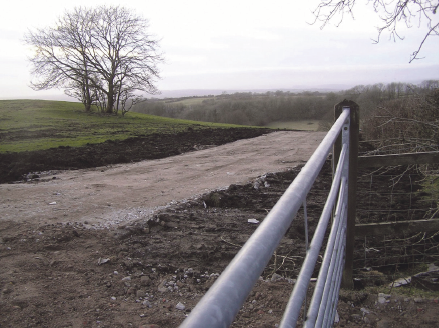
EMAILS released by Natural Resources Wales (NRW) under a Freedom of Information request reveal that once a protected site has been destroyed it is pretty much impossible to achieve its restoration.
Landowner Mr Andrew Thomas, of Blaenpant, Maesybont, had excavated and moved earth and constructed a roadway in a Special Area of Conservation of national and international importance. In addition, while the road is claimed to be required for an agricultural business, a search by The Herald for businesses registered to Mr Thomas show that he is shown only as a director of A.J.T. Recycling Ltd. A company whose sole purpose is described in company documents as ‘Wholesale of waste and scrap’.
SACs are of European importance and are supposed to receive the highest level of environmental protection. Mr Andrew Thomas and his late wife Karen purchased a modest farm at Blaenpant in 2001, and problems for people living nearby began almost immediately. Mr Thomas, whose background is in the travelling community, was not a farmer in any generally accepted sense, but a man whose main business interests are in road haulage, quarrying and scrap metal. He and his wife bought the farm ostensibly to breed horses, but it rapidly became clear to the neighbourhood that Blaenpant had become the operating hub for Mr Thomas’s other activities.
A fleet of HGVs was based at the farm, with all the noise that maintenance and operating those vehicles entails. Quarrying began, tyres were burned, horses escaped onto neighbouring properties, and all this went on seven days a week from very early in the morning until late at night. Last year, a major fire of tyres stored by Mr Thomas at nearby land resulted in a major response by emergency services. As he has before, Mr Thomas did not trouble himself to apply for planning permission until after a complaint had been made about his apparent disregard for planning law. Mr Thomas, who has what could be kindly described as a ‘chequered’ planning history has a track record of being accommodated at every turn by the County Council’s planning department, who have repeatedly adopted a laissez faire approach to enforcement against him that is at significant odds with actually performing its statutory function.
No smoke without fire
In addition to the holding at Blaenpant, Mr Thomas more recently acquired another property, described as a smallholding, a short distance away. In November, a major fire broke out in a large pile of waste tyres and timber at this second property. A total of 35 fire crew and a specialist environmental protection unit were called out, and it took 12 hours to bring the blaze under control in an operation which would have cost many thousands of pounds. It is not clear how the tyres ended up at the smallholding or whether Mr Thomas had the necessary licence for storing them on his land. Further questions are now being asked as to what it cost to tackle this blaze and the attendant environmental hazard, and whether the County Council, Natural Resources Wales or the Police will be seeking to bring a prosecution.
The rape of Cernydd Carmel

While it appears that the Council may now be taking a more hardnosed line, there is now a real risk that there is little that it can do that would actively deter Mr Thomas from doing as he likes. On its website, the Council claims that: ‘We regard the protection of the natural and built environment as a high priority in Carmarthenshire. The Conservation Section is actively working in partnership with local and national organisations as well as the community to assist in providing a high quality environment which retains its biodiversity, landscape characteristics and historical/cultural heritage.’ In practice, however, the Council is markedly less robust.
It has claimed in correspondence to a third party that the road follows and old track and may not require planning permission and that SAC and SSSI status, both of which apply to Cernydd Carmel only demonstrate ‘potential conservation value’. Research shows the old track and the course of the new road are at right angles to each other, while the Council’s relaxed view is not one shared elsewhere.
Cernydd Carmel, stretching from Gorslas towards Llandybie in Carmarthenshire, along a band of limestone, is protected because of rare features including its raised bogs, scree forests, wet heaths, dry heaths, and caves. The Countryside Council for Wales website reports that ‘Cernydd Carmel is situated immediately south of the village of Carmel in south Carmarthenshire. Of particular interest is Pant-y-Llyn turlough, an unusual seasonal lake with no natural inlet or outflow streams. It is fed entirely by groundwater from the underlying limestone aquifer, with its water level determined by seasonal variation in the groundwater table. Pant-y-Llyn is thought to be the only known example of its kind in mainland Britain’.
As for Mr Thomas and his agent, Mr Richard Banks of JCR Planning Ltd, the existence of this unique conservation area seems to be in some doubt. In answer to a series of questions on the Council’s application form asking whether any of the work for which they sought retrospective planning permission after scrubbing up the landscape would be detrimental to protected species, habitats, etc., they answered “no”.
The restoration game
When the series of released emails ended, on November 16th, the restoration plan was still not agreed. Mr Thomas had engaged consultants JCR Planning of Llanelli to represent him, and JCR’s representative– the name on the email was redacted to comply with data protection law, although Richard Banks of JCR is shown as Mr Thomas’ agent elsewhere – wrote on that day: “The purpose of the Restoration Report is to indicate the means of grazing the enclosure and use of the track over the next 10 year period, with a focus on restoring vegetation. It was not intended to address the issues of contours and past excavations from a ground re-profiling sense within that document.”
So, the damage caused by excavations was not to be repaired. Why so? It seems to be due to negotiations between Mr Thomas’s agents JCR Planning, NRW, and Carmarthenshire County Council, taking place between May and August 2015, about Enforcement Notices issued for the site. On May 8th, Huw Williams emailed a person or persons (names redacted), plus NRW’s development planning adviser Bonnie Palmer and senior environmental officer David Ellar, saying “NRW has a number of concerns regarding this application [to obtain planning permission for the track built across part of the SAC]. We would appreciate the opportunity to meet to discuss the case prior to potentially meeting with the applicant and his agents.”
A site meeting took place on June 5th, seemingly between Carmarthenshire County Council’s minerals and waste planning manager and JCR Planning. It was at this site meeting that it was apparently agreed between the persons present that it would be unrealistic to reinstate the site to its original – protected – state, but that an alternative plan must be prepared, and that if it would not be possible to have this ready by June 25th, JCR Planning, on behalf of their client Mr Thomas, should ask for more time. The county’s minerals and waste planning manager had “no issue with that”, as long as “progress is being made”.
NRW appointed Amber Consultancy to draw up a restoration plan for the ruined site. They seem badly informed about what has happened at Blaenpant, however; as the plan’s author appears to believe that the new road was simply reinstating a pre-existing track. They are also under the impression that the new road does not exit directly onto public roads, whereas it does in two places.
Progress was slow. On August 19th, someone at Carmarthenshire County Council emailed JCR Planning, Huw Williams at NRW, and two people in the county council, to say that, while it had been agreed it would be unrealistic to restore the land to its original state, a restoration scheme was required, but this scheme “was not submitted in compliance with the timeframe specified on the Enforcement Notice.”. Nevertheless, “an extension of time to submit the scheme beyond an additional 28 days would have been agreed….if it was requested in writing – which I do not appear to have. There is also a letter written by the Minerals and Waste Manager which confirms, and I quote, ‘If an alternative scheme is not submitted within 28 days the only option to you to comply with the requirements of the Enforcement Notice will be to restore the land to its former profile and condition before a revised date for compliance I have set at 31st August 2015’.”
The email continues: “I appreciate that restoring the land is not the route which will be taken, therefore, in the absence of the minerals and waste manager who is on annual leave at this time, all I can do is once again reiterate that the time given to comply with the Enforcement Notice is OVERDUE and the following information needs to be submitted as soon as possible: “Any alternative restoration scheme submitted shall include details of revised final contours and revised restoration details which shall include details of soil replacement profiles, soil handling, cultivation, planting and seeding as well as proposals for the construction and maintenance of tracks.”

A tale of two notices
Within 20 minutes, JCR Planning emailed back to recipients including Huw Williams at NRW as well as persons with redacted names, with a copy to an anonymous person at ecological consultants Amber Consultancy. The purpose of the email seems to be to play for more time. “Clearly, there are complicated ecological issues to be overcome on this site”, wrote JCR Planning, “and my clear understanding is that neither the NRW nor your Ecology colleagues did not [sic] advocate any future ground re-profiling, cultivation, seeding or planting to the grazing enclosure, or works to the existing track other than agricultural type fencing. Our draft Report seeks to establish such parameters. Hopefully if agreed, with or without revisions and amendments, the Management Report can form the basis of the current planning application for the track. How therefore can we submit a restoration scheme for the pasture to comply with an Enforcement Notice, when this was not the conclusion, or the agreed route to be taken, following the recent site meetings?? Can you please clarify matters?”
The next day, an email from someone (name redacted) at the county council to someone at JCR Planning, to Huw Williams at NRW, and two other people at the county council, reiterated that the first Enforcement Notice, E/ENF/07043, related to the unauthorised roadway. Mr Thomas had been instructed to submit a planning application “to regularise the development”, and this had been done. The second Enforcement Notice, E/ ENF/07016, applied to “unauthorised excavations and the use of materials that is not considered reasonable for the purposes of agriculture”. Mr Thomas had been ordered, on March 3rd 2015, to “cease the excavation and removal of material from the land for purposes which are not reasonably necessary for the purposes of agriculture”, and also to “reinstate the land to its former condition” or “in accordance with an alternative restoration scheme (which must be submitted for the approval of the Local Planning Authority within 28 days of this Notice taking effect)….”.
The option of an alternative restoration plan had to “include details of revised final contours and revised restoration details which shall include details of soil replacement profiles, soil handling, cultivation, planting and seeding as well as proposals for the construction and maintenance of tracks”. Although the restoration plan should have been submitted by March 31, during November arguments about it were still continuing, even though the aim of ‘restoration’ had been abandoned, and replaced by a watered-down idea to manage the remaining vegetation. If an area of landscape is so special that it is designated of European importance, as this site is, how come it is so simple to both damage it severely, and avoid any compulsion to reinstate it?
Pat Dodd Racher can be found at westwalesnewsreview.wordpress.com


















Add Comment